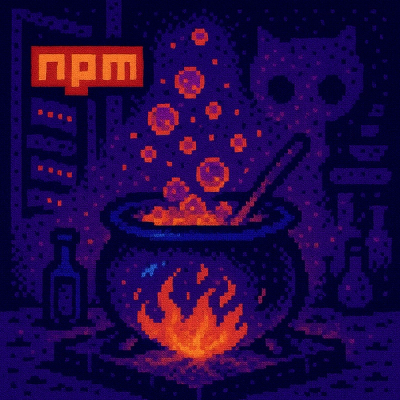
Security News
The Changelog Podcast: Practical Steps to Stay Safe on npm
Learn the essential steps every developer should take to stay secure on npm and reduce exposure to supply chain attacks.
experience-engine
Advanced tools
Create awesome experiences for your audience in seconds!
This is the experience-engine core. It is broken up into common parts. You can include just the part you need, or the whole thing by importing common.
"Activations" are related stuff that is associated with the parent content (i.e. the movie you're watching or the music you're listening to).
The activations format is a way of managing all the complexities associated with dealing with all the related content:
Activations can be "activated" or "queried", i.e. providing what/when/where.
If you ask for active activations, you'll get back a renderable list. If you query activations, you'll also get back instances that match.
{
"id": "uuid",
"settings": {
"text": "Hello"
},
"instances": [
{ "when": { "start": 1, "end": 15.7 }, "active": true },
]
},
We've spent years trying to make the data format as simple as possible. We've been able to cut complexity in half multiple times and feel we're at a place that is incredibly simplistic, yet more flexible than we even thought possible.
Generally, there are only 3 sections...
The id is a UUID and only there to keep track of where the source data came from. It will be generated for you and you can completely ignore it.
Settings behave exactly like content settings and use the same merge behaviors. Settings contain absolutely everything that is used to render the activation.
Sometimes you want to reference the same thing more than once in the same content; for example if a certain actor is on the screen multiple times, or if the same location in a film appears many times. Instances let you do that.
An instance of an activation also behaves exactly like settings; in fact, when an "active" query is made on media and a match is found on an instance, that instances object is simply merged into settings so it can be rendered.
An activation example...
{
"id": "4cd42cd5-e3bf-4d16-a5ab-b834c8f4a1d9",
"settings": {
"reference": "@activation:3f001fb3-15d0-40f2-b22c-0bb9f01928a8",
"icon": 'https://upload.wikimedia.org/wikipedia/commons/thumb/3/33/Tom_Cruise_by_Gage_Skidmore_2.jpg/476px-Tom_Cruise_by_Gage_Skidmore_2.jpg',
"details": {
"character": {
"name": "Pete \"maverick\" Mitchell"
}
}
},
"instances": [
{ "when": { "start": 1, "end": 15.7 }, "screen": { "top": 0.21, "left": 0.1, "width": 0.5, "height": 0.3 }, "details": "character": { "mood": "happy" }} },
{ "when": { "start": 112.3, "length": 7.22 }, "details": { "character": { "mood": "angry", "action": "jumping" } },
{ "when": { "start": 233, "length": 10 }, "where": "top", "active": true, "what": "trivia", "text": "@triviaText:details.birthplace" },
]
},
...The above shows:
Generating activations: It's worth noting that the text for the trivia came from a plugin called "triviaText", which was told to generate the trivia from the activation's birthplace details field, which amounts to something like: "Did you know? Tom Cruise was born in Syracuse, New York". The injection of the time, the length, where to place it, the decision to add trivia, and to add it about the person's birthplace, came from another plugin, called "@relevantTriviaGenerator, which uses details about when this instance is on screen, what the liklihood the audience will want to know the trivia is, and other factors; no human needed to add it.
You can get a list of what is active at any time with $common.activations.active(Activations, Query), where Activations is the list of activations you want to query, and Query is a query object, explained next.
The query object is pretty simple. It not only searches the activation settings, it searches all instances too...
{
"what": "person", // Filter for any text that matches the things you're interested in.
"when": 100 // The time in seconds you want to look at.
"where": "top-left", // Filter for any location the activation is meant to be drawn in.
}
Some examples...
Everything visible at 10.4 seconds...
$common.activations.active(Activations, { when: 10.4 })
Everything available (not just visible, i.e. this would include scene data, and all related instances as well) at 10.4 seconds...
$common.activations.query(Activations, { when: 10.4 })
Everything that appears in the "right" location...
$common.activations.query(Activations, { where: 'right' })
Everything that appears in the "top-right", "right", and "bottom-right" location...
$common.activations.query(Activations, { where: 'top-right', 'right', 'bottom-right' })
Everything visible in the "right" location at 22 seconds, that is also a person...
$common.activations.active(Activations, { where: 'right', what: 'person', when: 22 })
Get a list of all locations and related data...
$common.activations.query(Activations, { what: 'place' })
FAQs
The experience-engine core SDK
We found that experience-engine demonstrated a not healthy version release cadence and project activity because the last version was released a year ago. It has 1 open source maintainer collaborating on the project.
Did you know?

Socket for GitHub automatically highlights issues in each pull request and monitors the health of all your open source dependencies. Discover the contents of your packages and block harmful activity before you install or update your dependencies.

Security News
Learn the essential steps every developer should take to stay secure on npm and reduce exposure to supply chain attacks.

Security News
Experts push back on new claims about AI-driven ransomware, warning that hype and sponsored research are distorting how the threat is understood.

Security News
Ruby's creator Matz assumes control of RubyGems and Bundler repositories while former maintainers agree to step back and transfer all rights to end the dispute.